The impact of energy consumption on Carbon Intensity of Human Well-Being (CIWB)
A key concern when constructing sustainable development policy is reducing the negative impact on environmental systems and maximizing human welfare. In this study, we assess how energy consumption effected on Carbon intensity of human wellbeing (CIWB). Using two-Way fixed effects in panel regression, this relationship has been investigated during 2000-2018 for 9 lower middle-income countries including Algeria, Bangladesh, Egypt, India, Morocco, Pakistan, Philippines, Uzbekistan and Vietnam, while adding GDP and FDI per capita as control variables. The study reveals that the use of energy for economic development is ineffective and inconsistent with the overview of sustainable development due to the result of increasing CIWB. However, the sign of negative coefficients of GDP and FDI per capita in control variables have given the striking findings that these factors will be helpful for lower middle - income countries to pursue sustainable development by reducing CIWB
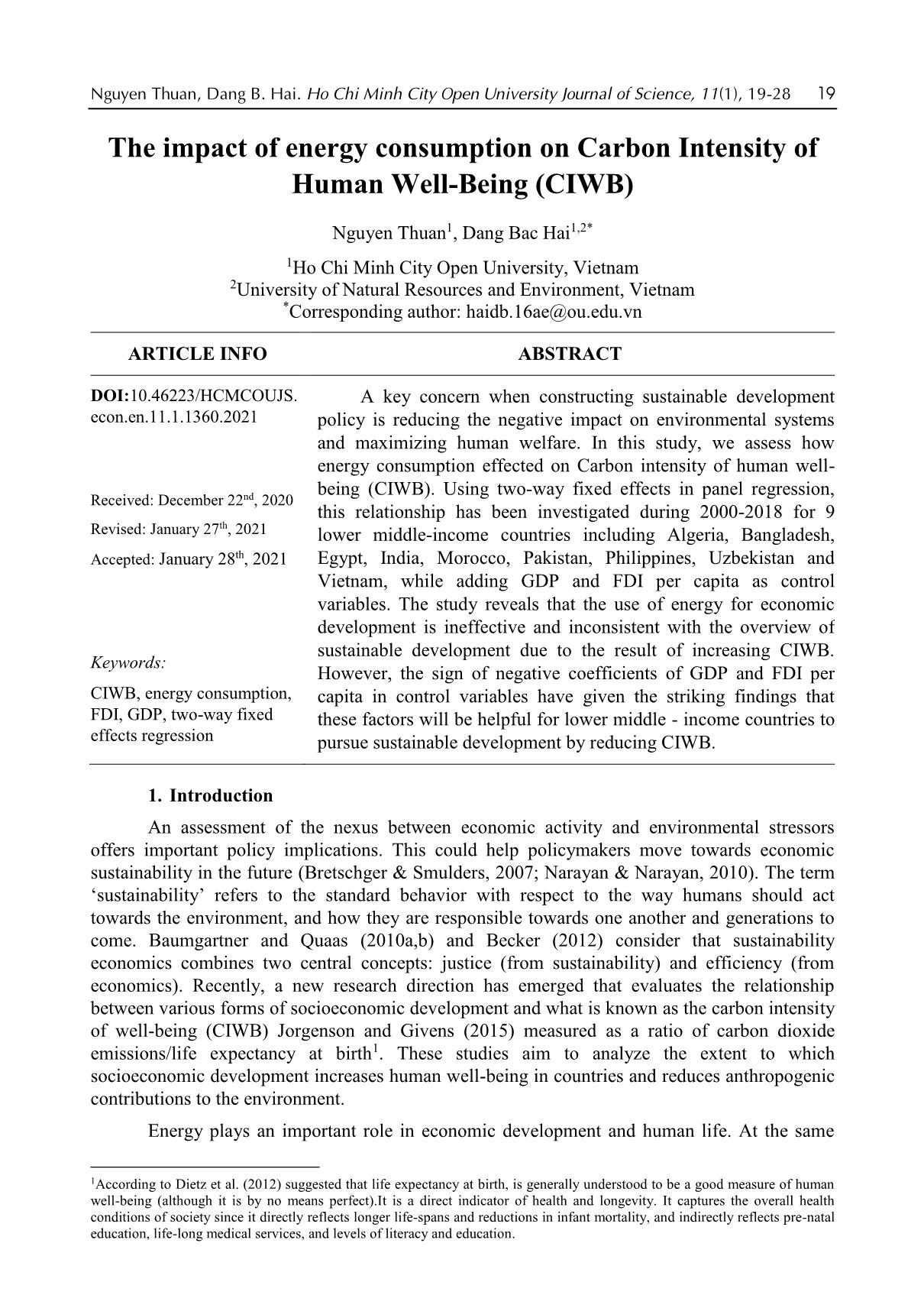
Trang 1
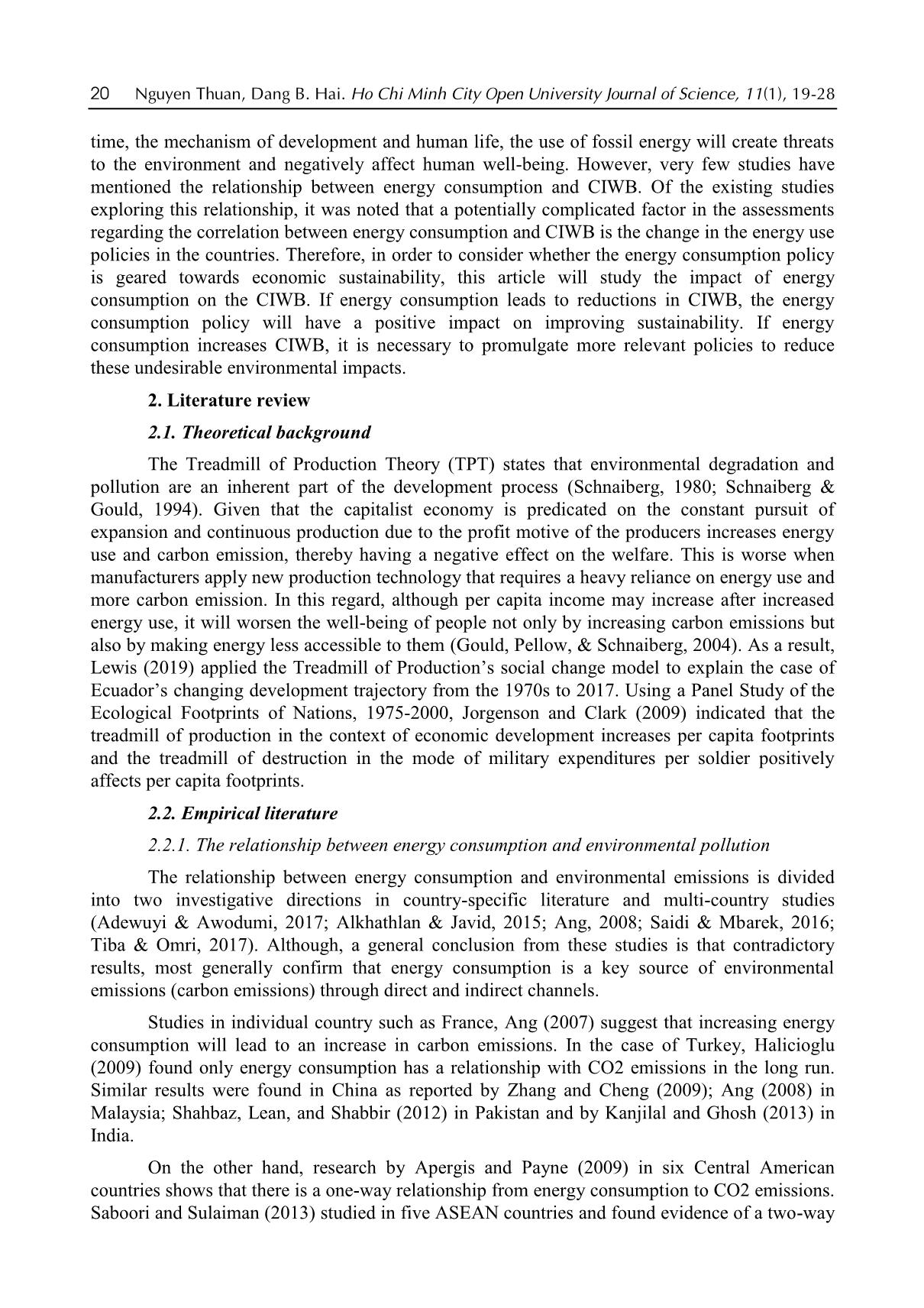
Trang 2
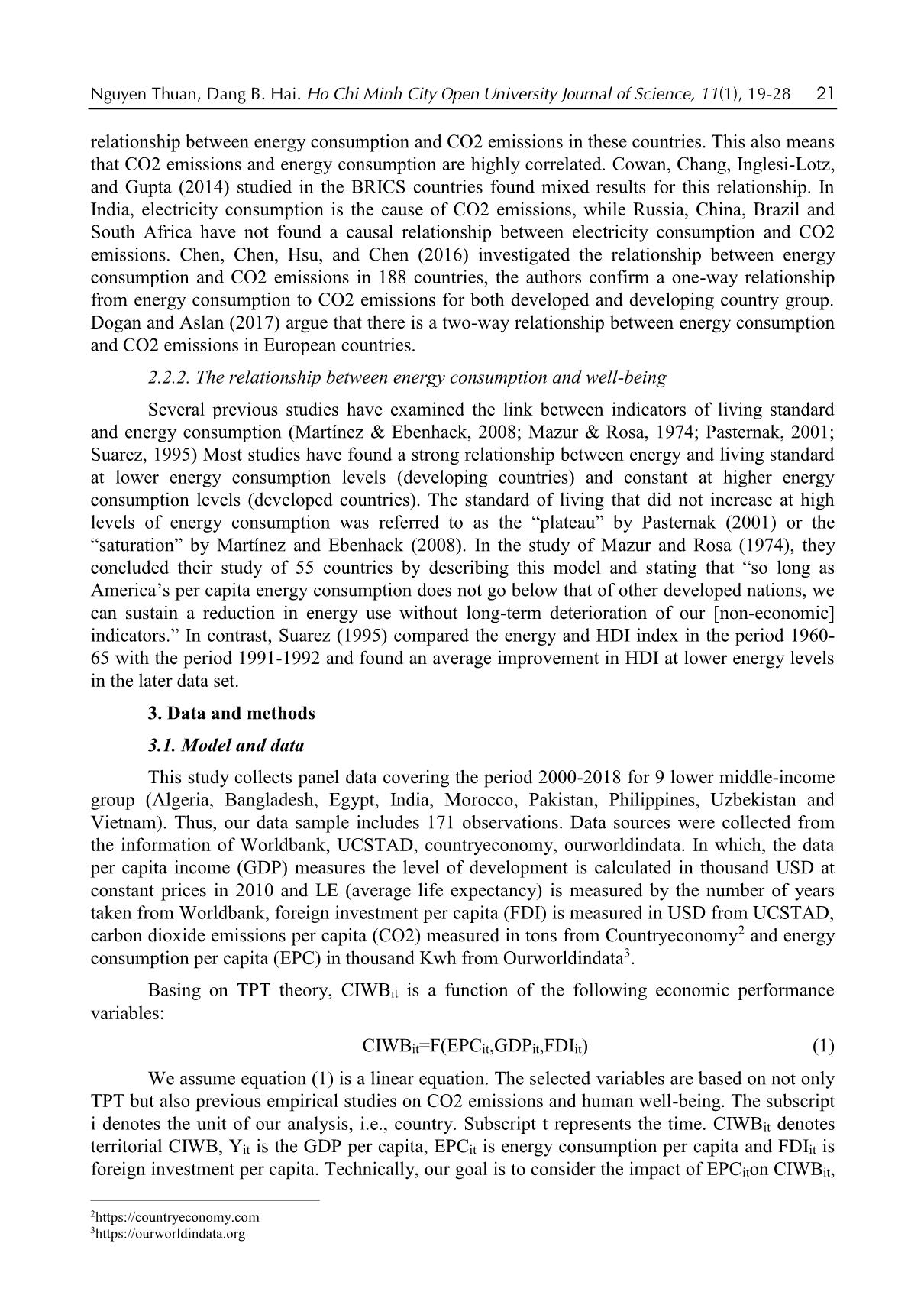
Trang 3
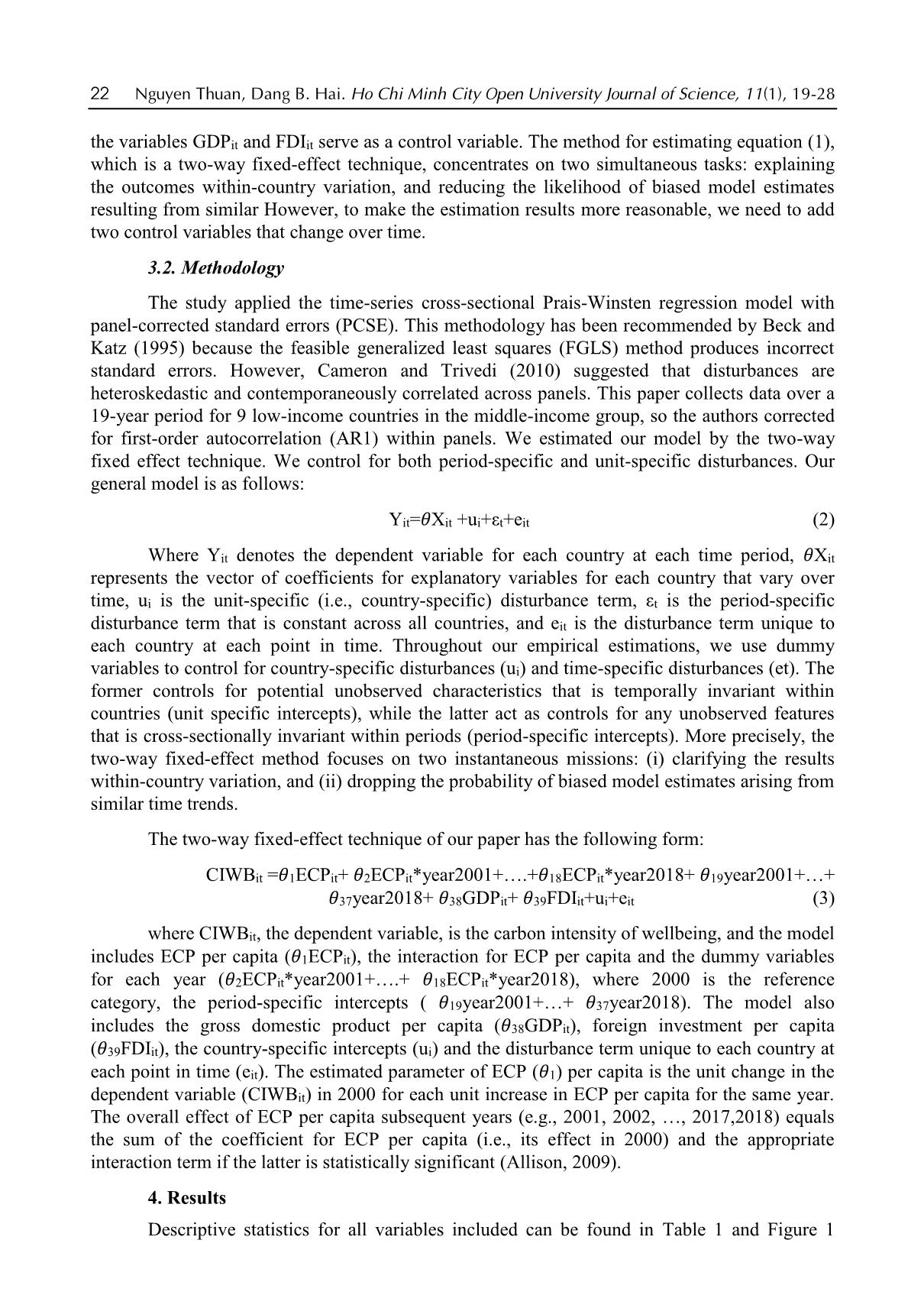
Trang 4
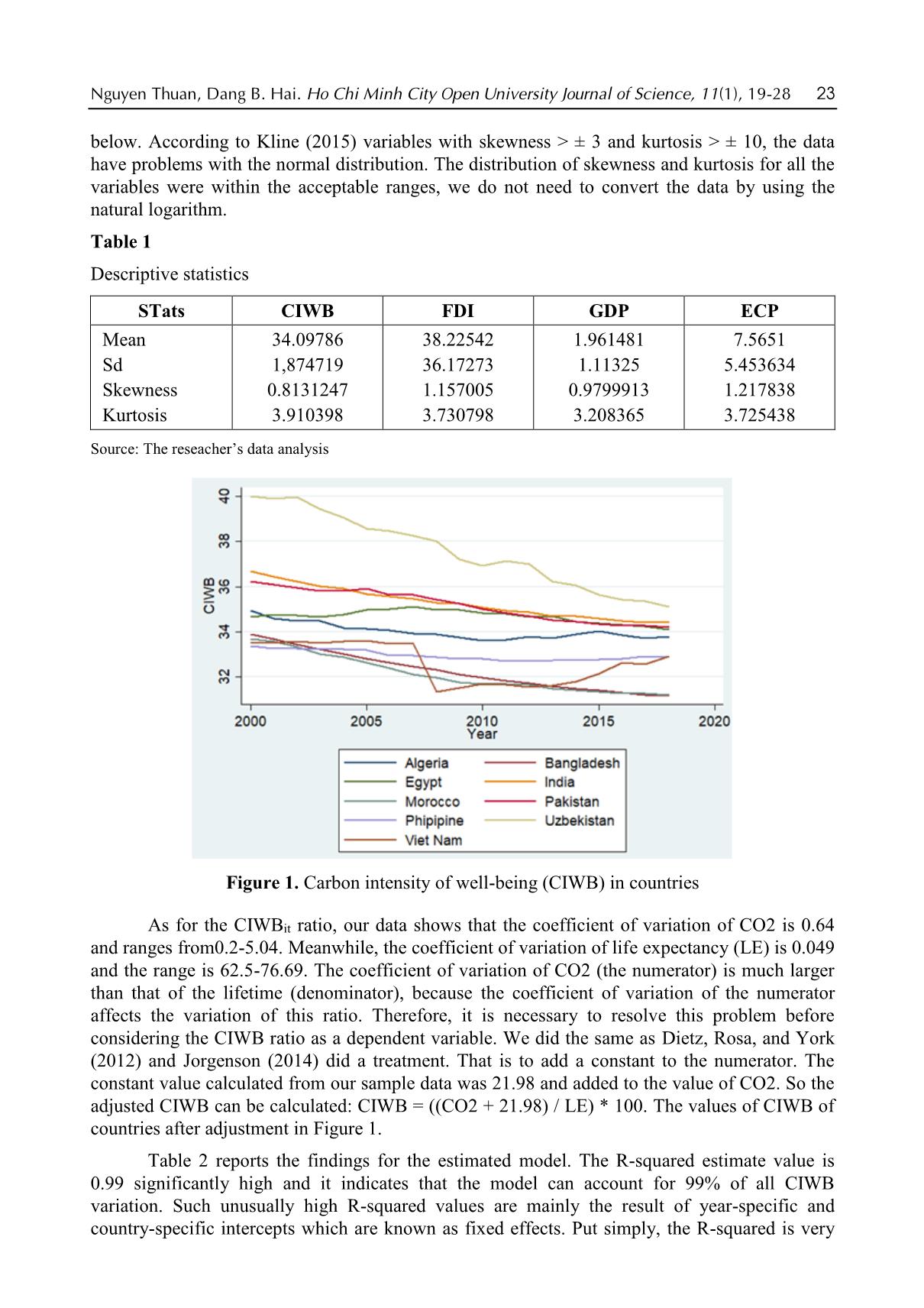
Trang 5
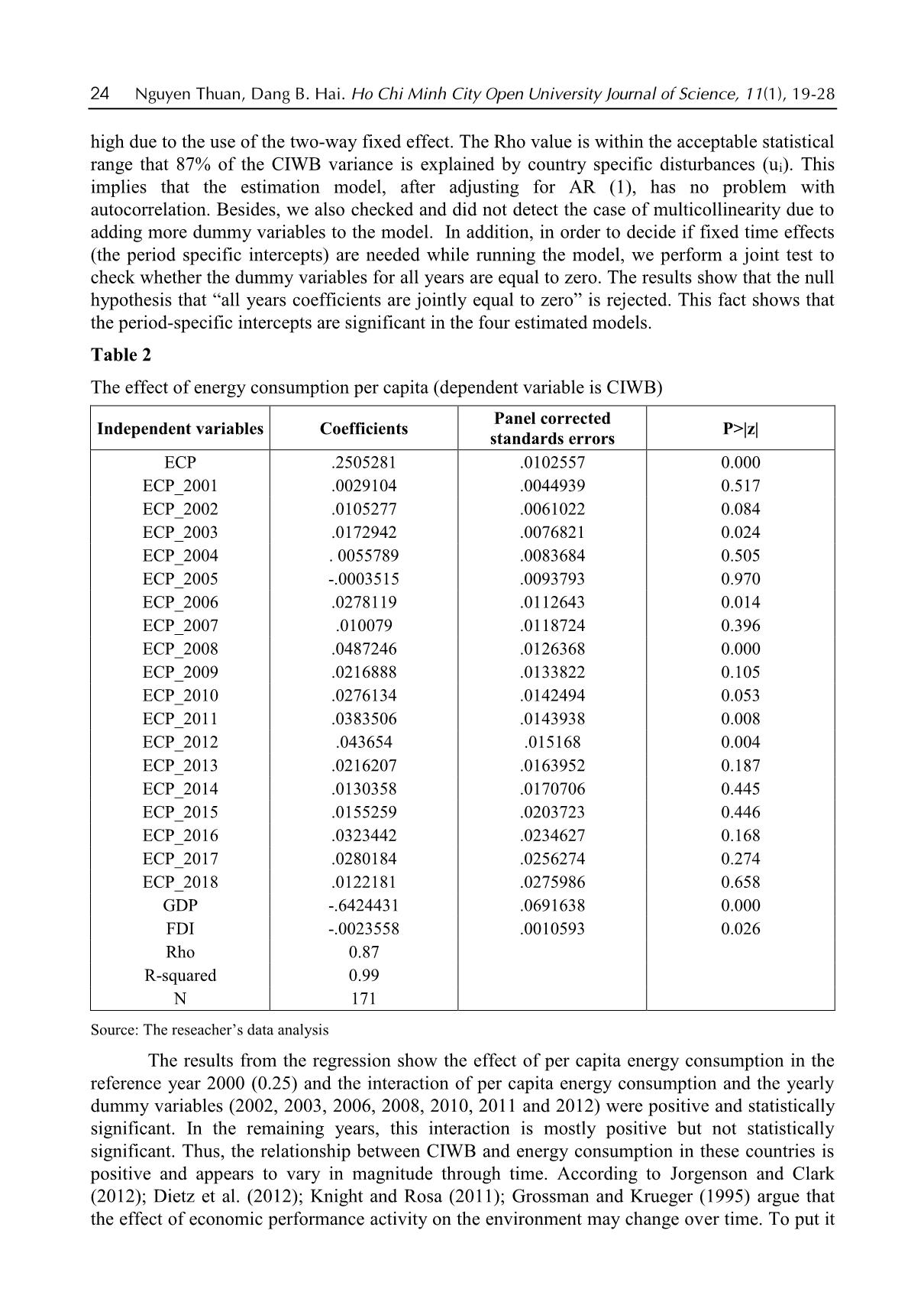
Trang 6
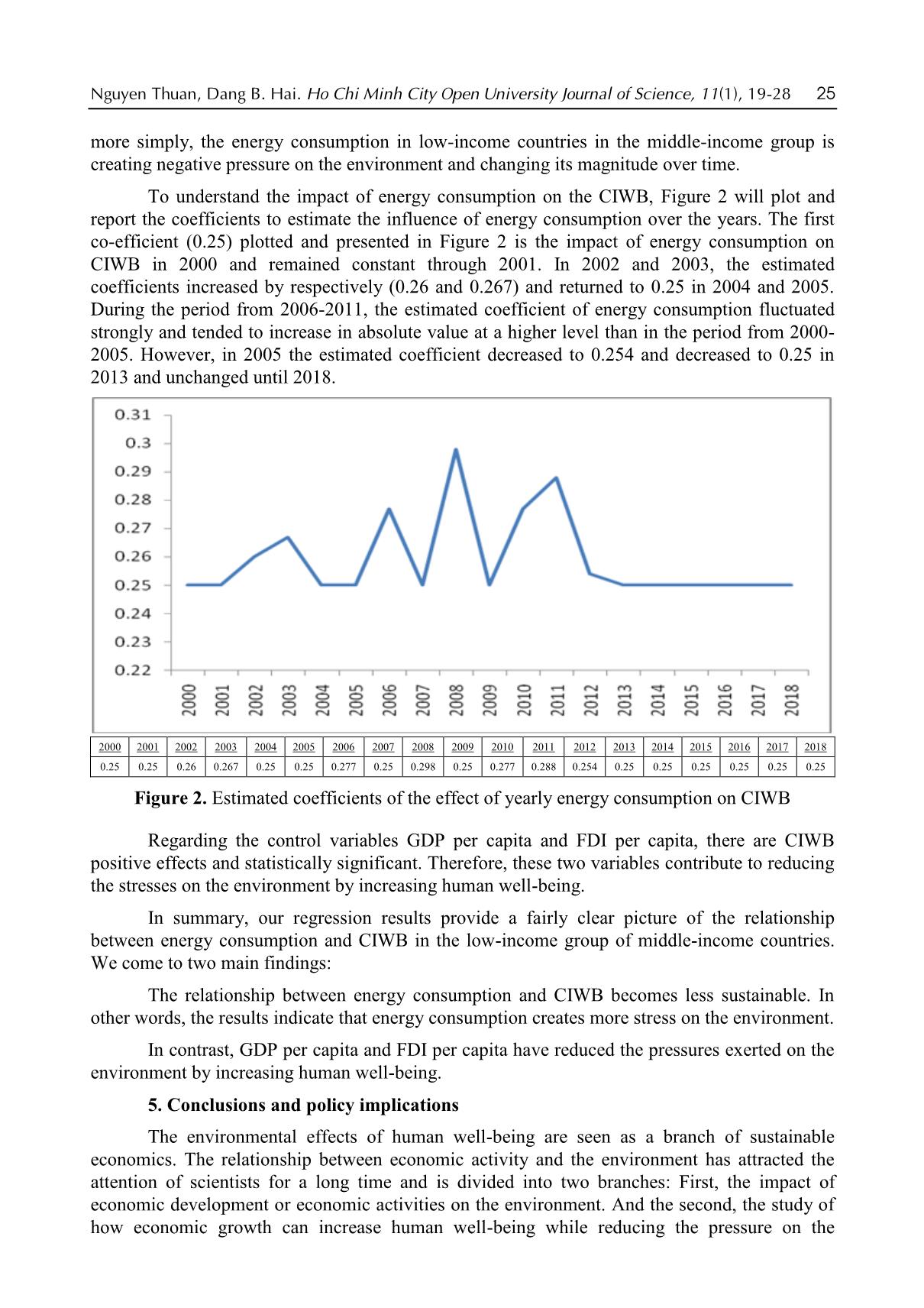
Trang 7
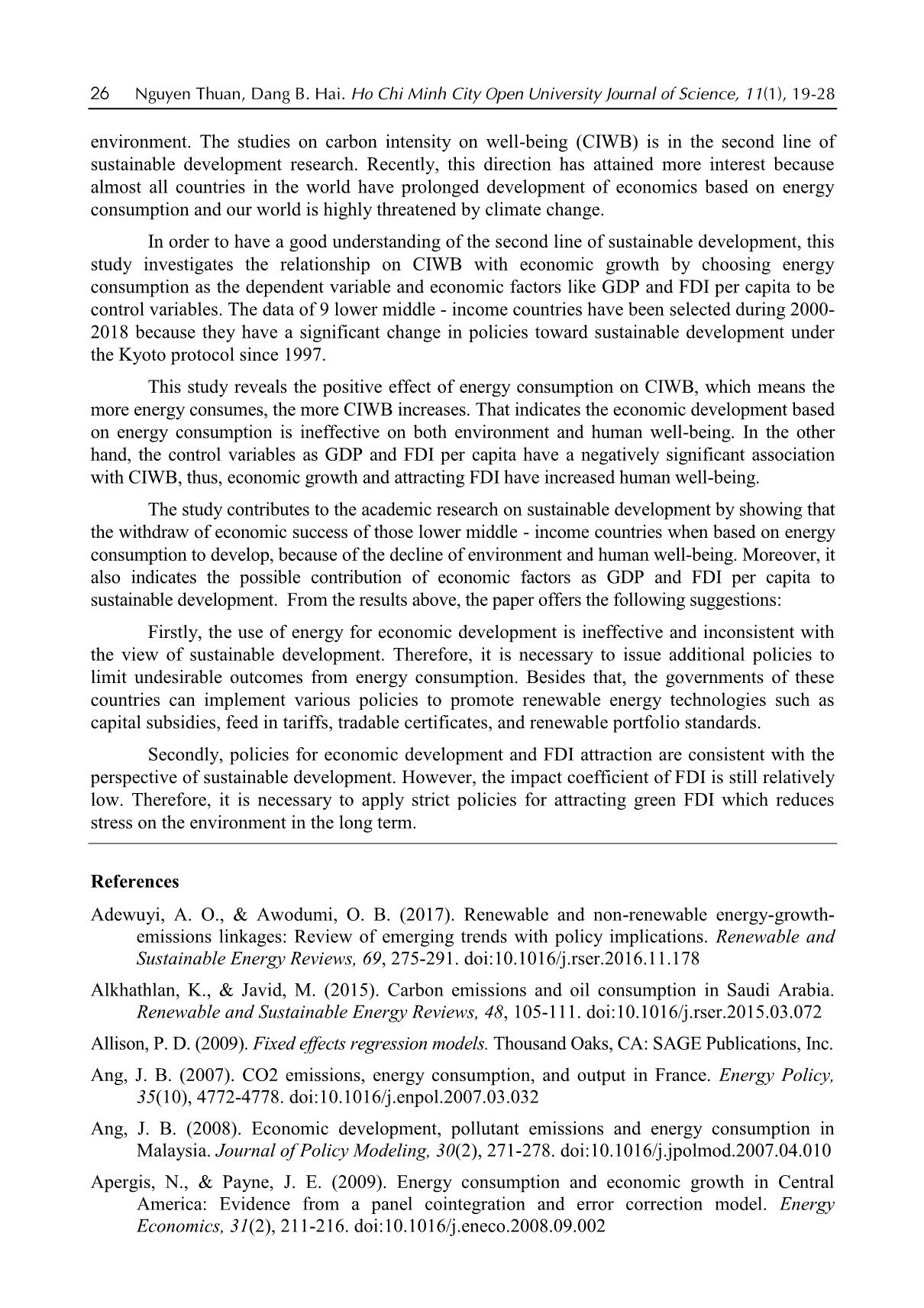
Trang 8
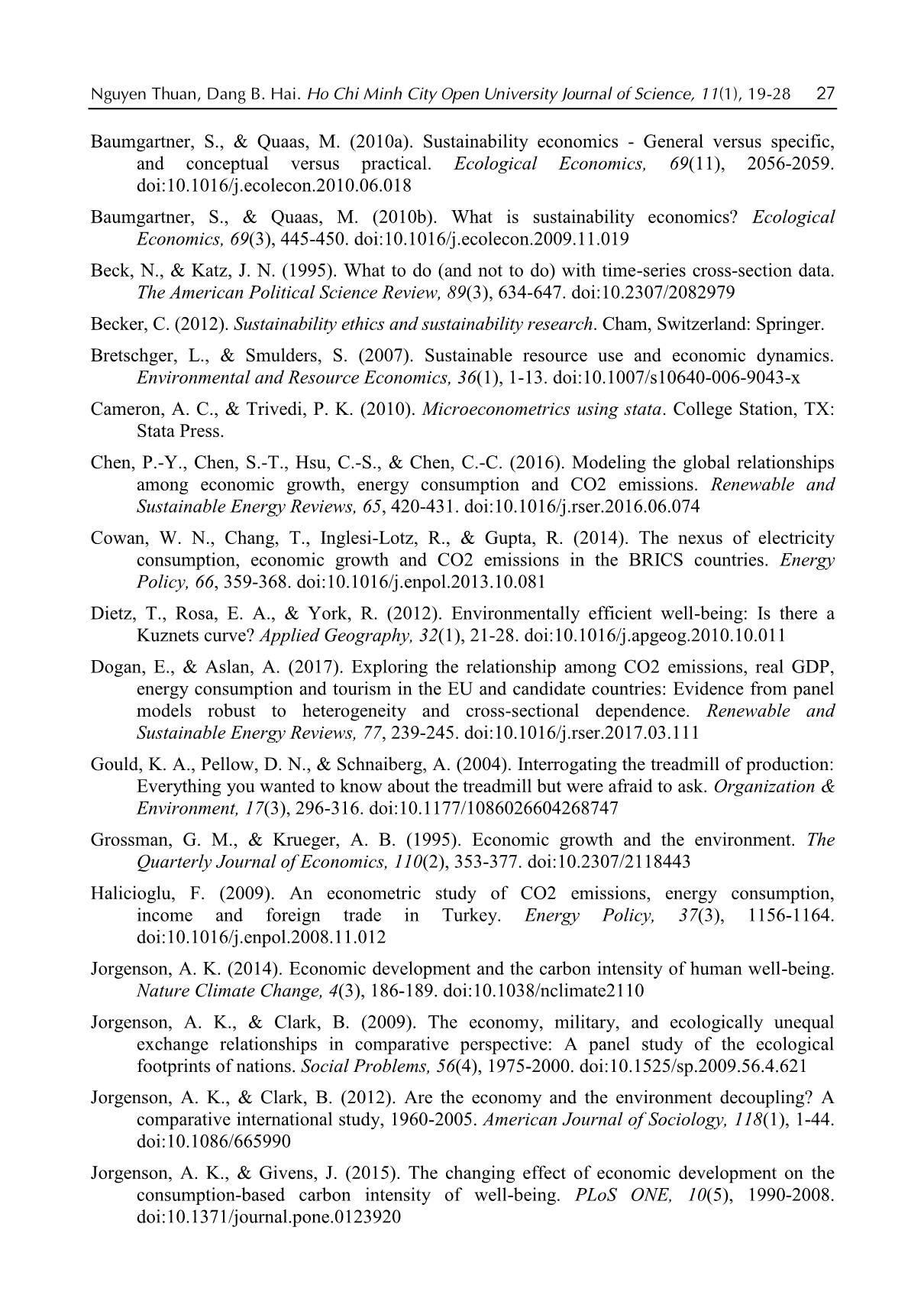
Trang 9
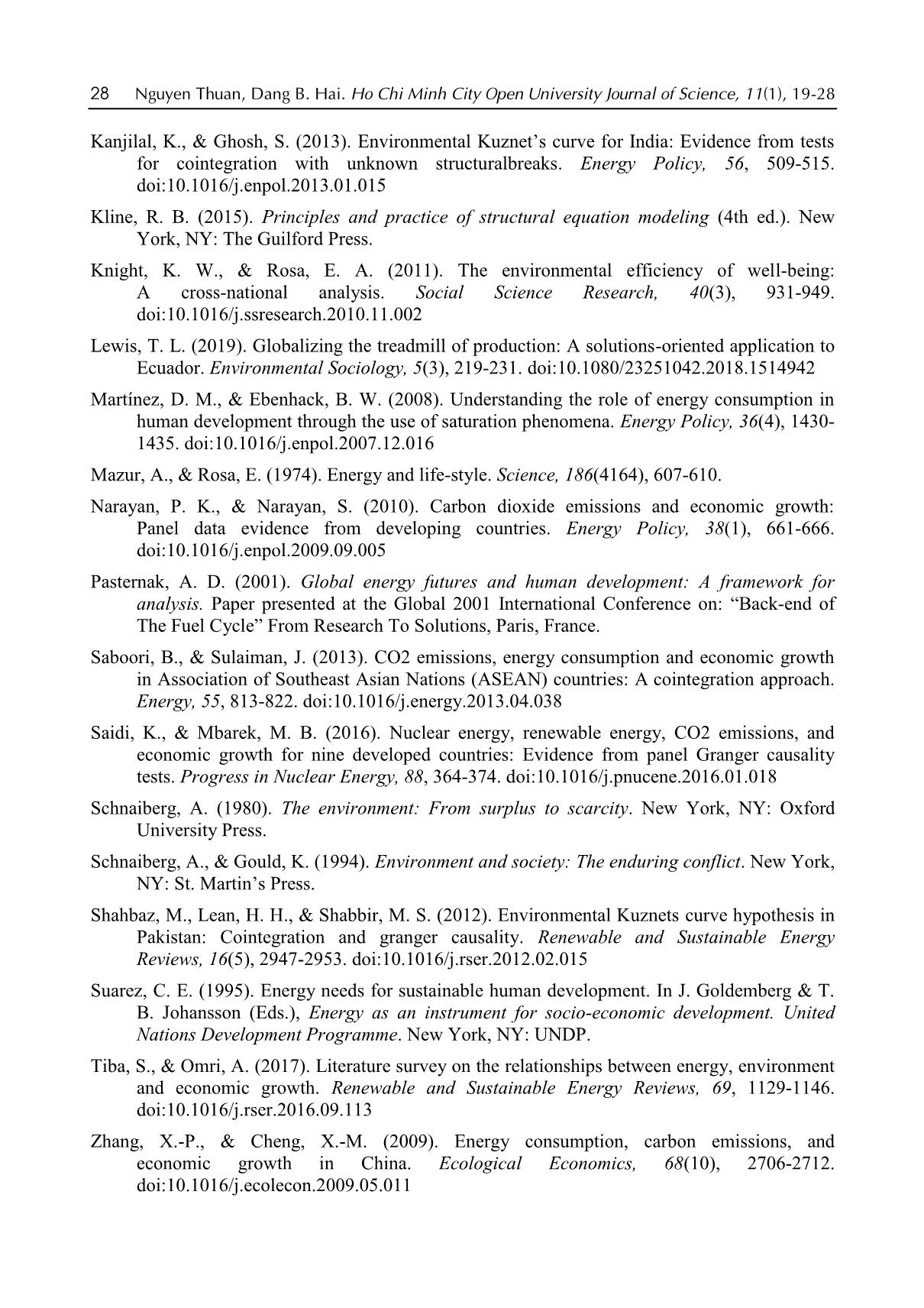
Trang 10
Tóm tắt nội dung tài liệu: The impact of energy consumption on Carbon Intensity of Human Well-Being (CIWB)
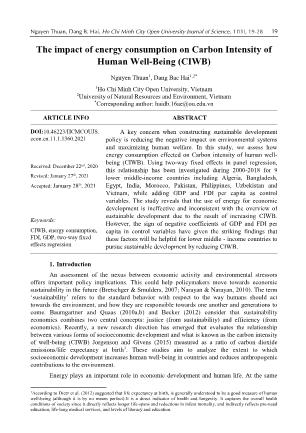
joint test to check whether the dummy variables for all years are equal to zero. The results show that the null hypothesis that “all years coefficients are jointly equal to zero” is rejected. This fact shows that the period-specific intercepts are significant in the four estimated models. Table 2 The effect of energy consumption per capita (dependent variable is CIWB) Independent variables Coefficients Panel corrected standards errors P>|z| ECP .2505281 .0102557 0.000 ECP_2001 .0029104 .0044939 0.517 ECP_2002 .0105277 .0061022 0.084 ECP_2003 .0172942 .0076821 0.024 ECP_2004 . 0055789 .0083684 0.505 ECP_2005 -.0003515 .0093793 0.970 ECP_2006 .0278119 .0112643 0.014 ECP_2007 .010079 .0118724 0.396 ECP_2008 .0487246 .0126368 0.000 ECP_2009 .0216888 .0133822 0.105 ECP_2010 .0276134 .0142494 0.053 ECP_2011 .0383506 .0143938 0.008 ECP_2012 .043654 .015168 0.004 ECP_2013 .0216207 .0163952 0.187 ECP_2014 .0130358 .0170706 0.445 ECP_2015 .0155259 .0203723 0.446 ECP_2016 .0323442 .0234627 0.168 ECP_2017 .0280184 .0256274 0.274 ECP_2018 .0122181 .0275986 0.658 GDP -.6424431 .0691638 0.000 FDI -.0023558 .0010593 0.026 Rho 0.87 R-squared 0.99 N 171 Source: The reseacher’s data analysis The results from the regression show the effect of per capita energy consumption in the reference year 2000 (0.25) and the interaction of per capita energy consumption and the yearly dummy variables (2002, 2003, 2006, 2008, 2010, 2011 and 2012) were positive and statistically significant. In the remaining years, this interaction is mostly positive but not statistically significant. Thus, the relationship between CIWB and energy consumption in these countries is positive and appears to vary in magnitude through time. According to Jorgenson and Clark (2012); Dietz et al. (2012); Knight and Rosa (2011); Grossman and Krueger (1995) argue that the effect of economic performance activity on the environment may change over time. To put it Nguyen Thuan, Dang B. Hai. Ho Chi Minh City Open University Journal of Science, 11(1), 19-28 25 more simply, the energy consumption in low-income countries in the middle-income group is creating negative pressure on the environment and changing its magnitude over time. To understand the impact of energy consumption on the CIWB, Figure 2 will plot and report the coefficients to estimate the influence of energy consumption over the years. The first co-efficient (0.25) plotted and presented in Figure 2 is the impact of energy consumption on CIWB in 2000 and remained constant through 2001. In 2002 and 2003, the estimated coefficients increased by respectively (0.26 and 0.267) and returned to 0.25 in 2004 and 2005. During the period from 2006-2011, the estimated coefficient of energy consumption fluctuated strongly and tended to increase in absolute value at a higher level than in the period from 2000- 2005. However, in 2005 the estimated coefficient decreased to 0.254 and decreased to 0.25 in 2013 and unchanged until 2018. 2000 2001 2002 2003 2004 2005 2006 2007 2008 2009 2010 2011 2012 2013 2014 2015 2016 2017 2018 0.25 0.25 0.26 0.267 0.25 0.25 0.277 0.25 0.298 0.25 0.277 0.288 0.254 0.25 0.25 0.25 0.25 0.25 0.25 Figure 2. Estimated coefficients of the effect of yearly energy consumption on CIWB Regarding the control variables GDP per capita and FDI per capita, there are CIWB positive effects and statistically significant. Therefore, these two variables contribute to reducing the stresses on the environment by increasing human well-being. In summary, our regression results provide a fairly clear picture of the relationship between energy consumption and CIWB in the low-income group of middle-income countries. We come to two main findings: The relationship between energy consumption and CIWB becomes less sustainable. In other words, the results indicate that energy consumption creates more stress on the environment. In contrast, GDP per capita and FDI per capita have reduced the pressures exerted on the environment by increasing human well-being. 5. Conclusions and policy implications The environmental effects of human well-being are seen as a branch of sustainable economics. The relationship between economic activity and the environment has attracted the attention of scientists for a long time and is divided into two branches: First, the impact of economic development or economic activities on the environment. And the second, the study of how economic growth can increase human well-being while reducing the pressure on the 26 Nguyen Thuan, Dang B. Hai. Ho Chi Minh City Open University Journal of Science, 11(1), 19-28 environment. The studies on carbon intensity on well-being (CIWB) is in the second line of sustainable development research. Recently, this direction has attained more interest because almost all countries in the world have prolonged development of economics based on energy consumption and our world is highly threatened by climate change. In order to have a good understanding of the second line of sustainable development, this study investigates the relationship on CIWB with economic growth by choosing energy consumption as the dependent variable and economic factors like GDP and FDI per capita to be control variables. The data of 9 lower middle - income countries have been selected during 2000- 2018 because they have a significant change in policies toward sustainable development under the Kyoto protocol since 1997. This study reveals the positive effect of energy consumption on CIWB, which means the more energy consumes, the more CIWB increases. That indicates the economic development based on energy consumption is ineffective on both environment and human well-being. In the other hand, the control variables as GDP and FDI per capita have a negatively significant association with CIWB, thus, economic growth and attracting FDI have increased human well-being. The study contributes to the academic research on sustainable development by showing that the withdraw of economic success of those lower middle - income countries when based on energy consumption to develop, because of the decline of environment and human well-being. Moreover, it also indicates the possible contribution of economic factors as GDP and FDI per capita to sustainable development. From the results above, the paper offers the following suggestions: Firstly, the use of energy for economic development is ineffective and inconsistent with the view of sustainable development. Therefore, it is necessary to issue additional policies to limit undesirable outcomes from energy consumption. Besides that, the governments of these countries can implement various policies to promote renewable energy technologies such as capital subsidies, feed in tariffs, tradable certificates, and renewable portfolio standards. Secondly, policies for economic development and FDI attraction are consistent with the perspective of sustainable development. However, the impact coefficient of FDI is still relatively low. Therefore, it is necessary to apply strict policies for attracting green FDI which reduces stress on the environment in the long term. References Adewuyi, A. O., & Awodumi, O. B. (2017). Renewable and non-renewable energy-growth- emissions linkages: Review of emerging trends with policy implications. Renewable and Sustainable Energy Reviews, 69, 275-291. doi:10.1016/j.rser.2016.11.178 Alkhathlan, K., & Javid, M. (2015). Carbon emissions and oil consumption in Saudi Arabia. Renewable and Sustainable Energy Reviews, 48, 105-111. doi:10.1016/j.rser.2015.03.072 Allison, P. D. (2009). Fixed effects regression models. Thousand Oaks, CA: SAGE Publications, Inc. Ang, J. B. (2007). CO2 emissions, energy consumption, and output in France. Energy Policy, 35(10), 4772-4778. doi:10.1016/j.enpol.2007.03.032 Ang, J. B. (2008). Economic development, pollutant emissions and energy consumption in Malaysia. Journal of Policy Modeling, 30(2), 271-278. doi:10.1016/j.jpolmod.2007.04.010 Apergis, N., & Payne, J. E. (2009). Energy consumption and economic growth in Central America: Evidence from a panel cointegration and error correction model. Energy Economics, 31(2), 211-216. doi:10.1016/j.eneco.2008.09.002 Nguyen Thuan, Dang B. Hai. Ho Chi Minh City Open University Journal of Science, 11(1), 19-28 27 Baumgartner, S., & Quaas, M. (2010a). Sustainability economics - General versus specific, and conceptual versus practical. Ecological Economics, 69(11), 2056-2059. doi:10.1016/j.ecolecon.2010.06.018 Baumgartner, S., & Quaas, M. (2010b). What is sustainability economics? Ecological Economics, 69(3), 445-450. doi:10.1016/j.ecolecon.2009.11.019 Beck, N., & Katz, J. N. (1995). What to do (and not to do) with time-series cross-section data. The American Political Science Review, 89(3), 634-647. doi:10.2307/2082979 Becker, C. (2012). Sustainability ethics and sustainability research. Cham, Switzerland: Springer. Bretschger, L., & Smulders, S. (2007). Sustainable resource use and economic dynamics. Environmental and Resource Economics, 36(1), 1-13. doi:10.1007/s10640-006-9043-x Cameron, A. C., & Trivedi, P. K. (2010). Microeconometrics using stata. College Station, TX: Stata Press. Chen, P.-Y., Chen, S.-T., Hsu, C.-S., & Chen, C.-C. (2016). Modeling the global relationships among economic growth, energy consumption and CO2 emissions. Renewable and Sustainable Energy Reviews, 65, 420-431. doi:10.1016/j.rser.2016.06.074 Cowan, W. N., Chang, T., Inglesi-Lotz, R., & Gupta, R. (2014). The nexus of electricity consumption, economic growth and CO2 emissions in the BRICS countries. Energy Policy, 66, 359-368. doi:10.1016/j.enpol.2013.10.081 Dietz, T., Rosa, E. A., & York, R. (2012). Environmentally efficient well-being: Is there a Kuznets curve? Applied Geography, 32(1), 21-28. doi:10.1016/j.apgeog.2010.10.011 Dogan, E., & Aslan, A. (2017). Exploring the relationship among CO2 emissions, real GDP, energy consumption and tourism in the EU and candidate countries: Evidence from panel models robust to heterogeneity and cross-sectional dependence. Renewable and Sustainable Energy Reviews, 77, 239-245. doi:10.1016/j.rser.2017.03.111 Gould, K. A., Pellow, D. N., & Schnaiberg, A. (2004). Interrogating the treadmill of production: Everything you wanted to know about the treadmill but were afraid to ask. Organization & Environment, 17(3), 296-316. doi:10.1177/1086026604268747 Grossman, G. M., & Krueger, A. B. (1995). Economic growth and the environment. The Quarterly Journal of Economics, 110(2), 353-377. doi:10.2307/2118443 Halicioglu, F. (2009). An econometric study of CO2 emissions, energy consumption, income and foreign trade in Turkey. Energy Policy, 37(3), 1156-1164. doi:10.1016/j.enpol.2008.11.012 Jorgenson, A. K. (2014). Economic development and the carbon intensity of human well-being. Nature Climate Change, 4(3), 186-189. doi:10.1038/nclimate2110 Jorgenson, A. K., & Clark, B. (2009). The economy, military, and ecologically unequal exchange relationships in comparative perspective: A panel study of the ecological footprints of nations. Social Problems, 56(4), 1975-2000. doi:10.1525/sp.2009.56.4.621 Jorgenson, A. K., & Clark, B. (2012). Are the economy and the environment decoupling? A comparative international study, 1960-2005. American Journal of Sociology, 118(1), 1-44. doi:10.1086/665990 Jorgenson, A. K., & Givens, J. (2015). The changing effect of economic development on the consumption-based carbon intensity of well-being. PLoS ONE, 10(5), 1990-2008. doi:10.1371/journal.pone.0123920 28 Nguyen Thuan, Dang B. Hai. Ho Chi Minh City Open University Journal of Science, 11(1), 19-28 Kanjilal, K., & Ghosh, S. (2013). Environmental Kuznet’s curve for India: Evidence from tests for cointegration with unknown structuralbreaks. Energy Policy, 56, 509-515. doi:10.1016/j.enpol.2013.01.015 Kline, R. B. (2015). Principles and practice of structural equation modeling (4th ed.). New York, NY: The Guilford Press. Knight, K. W., & Rosa, E. A. (2011). The environmental efficiency of well-being: A cross-national analysis. Social Science Research, 40(3), 931-949. doi:10.1016/j.ssresearch.2010.11.002 Lewis, T. L. (2019). Globalizing the treadmill of production: A solutions-oriented application to Ecuador. Environmental Sociology, 5(3), 219-231. doi:10.1080/23251042.2018.1514942 Martínez, D. M., & Ebenhack, B. W. (2008). Understanding the role of energy consumption in human development through the use of saturation phenomena. Energy Policy, 36(4), 1430- 1435. doi:10.1016/j.enpol.2007.12.016 Mazur, A., & Rosa, E. (1974). Energy and life-style. Science, 186(4164), 607-610. Narayan, P. K., & Narayan, S. (2010). Carbon dioxide emissions and economic growth: Panel data evidence from developing countries. Energy Policy, 38(1), 661-666. doi:10.1016/j.enpol.2009.09.005 Pasternak, A. D. (2001). Global energy futures and human development: A framework for analysis. Paper presented at the Global 2001 International Conference on: “Back-end of The Fuel Cycle” From Research To Solutions, Paris, France. Saboori, B., & Sulaiman, J. (2013). CO2 emissions, energy consumption and economic growth in Association of Southeast Asian Nations (ASEAN) countries: A cointegration approach. Energy, 55, 813-822. doi:10.1016/j.energy.2013.04.038 Saidi, K., & Mbarek, M. B. (2016). Nuclear energy, renewable energy, CO2 emissions, and economic growth for nine developed countries: Evidence from panel Granger causality tests. Progress in Nuclear Energy, 88, 364-374. doi:10.1016/j.pnucene.2016.01.018 Schnaiberg, A. (1980). The environment: From surplus to scarcity. New York, NY: Oxford University Press. Schnaiberg, A., & Gould, K. (1994). Environment and society: The enduring conflict. New York, NY: St. Martin’s Press. Shahbaz, M., Lean, H. H., & Shabbir, M. S. (2012). Environmental Kuznets curve hypothesis in Pakistan: Cointegration and granger causality. Renewable and Sustainable Energy Reviews, 16(5), 2947-2953. doi:10.1016/j.rser.2012.02.015 Suarez, C. E. (1995). Energy needs for sustainable human development. In J. Goldemberg & T. B. Johansson (Eds.), Energy as an instrument for socio-economic development. United Nations Development Programme. New York, NY: UNDP. Tiba, S., & Omri, A. (2017). Literature survey on the relationships between energy, environment and economic growth. Renewable and Sustainable Energy Reviews, 69, 1129-1146. doi:10.1016/j.rser.2016.09.113 Zhang, X.-P., & Cheng, X.-M. (2009). Energy consumption, carbon emissions, and economic growth in China. Ecological Economics, 68(10), 2706-2712. doi:10.1016/j.ecolecon.2009.05.011
File đính kèm:
 the_impact_of_energy_consumption_on_carbon_intensity_of_huma.pdf
the_impact_of_energy_consumption_on_carbon_intensity_of_huma.pdf

